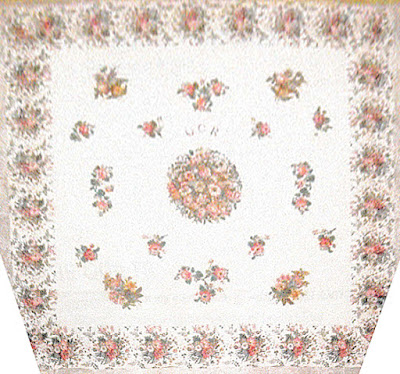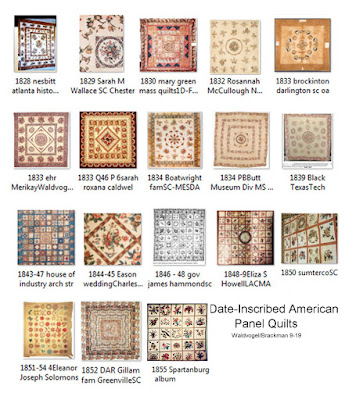In her 2013 AQSG paper "Printed Panels for Chintz
Quilts" analyzing her study of panels and the quilts using them, Merikay
Waldvogel presented several conclusions. After two years of summarizing her data
and looking at new examples on this blog we can confirm and update those conclusions.
See the abstract for the paper here:
Recent photos of a quilt dated 1839 in the collection of Texas Tech University's museum
One of the most useful findings is in dating the panels and dating the quilts.
George III's 50th anniversary on the throne was celebrated
in 1809 and 1810 (Panel #24)
She noted that about fifty years ago Peter Floud and Florence Montgomery dated the actual panels
to originating "about 1815" (a span of 1810-1820). Nothing has changed that estimate or defined it more specifically. The earliest panel example
seems to be the King George III Jubilee design (1809-1810), which may have
initiated the fashion. Four panels are associated with events (Jubilee, two similar Wellington Victory Panels, 1813 & 1815, & Princess Charlotte's 1817 wedding)
As Merikay wrote: "The 'about 1815' date pertains only to the panel not the quilt."
Panel #9, from a pillow cover in Lenna DeMarco's collection
Floud and Montgomery identified 10 panels; her paper indexed 32. The database now includes several more. That paper looked at 185 quilts from the U.S. and the U.K.; the database now includes 255 quilts.
British quilt dated 1834, Panel #26, Wellington Victory
She also found that the panels appeared in quilts over a
longer-than-expected 50-year time span with dated examples ranging from 1828 -
1869.
Without this outlier the range in the U.S. and the U.K. is now 1810 - 1855.
The one quilt dated after 1855 is 1869, so much an outlier from similar medallions that we are not going to consider that as the date it was made.
"O.C.R. 1869" Reddick Family, found in Florida,
probably originated near Augusta, Georgia in
South Carolina in the 1825-1840 period.
A top now in Cathy Erickson's collection.
Dated British quilts range from 1810 to 1834.
Dated American quilts range from 1828 to 1855.
If you put them on the same timeline you can see the lag in US quilts.
This indicates that a reasonable estimate for an undated American medallion is 1825-1840; an estimate for a block-style chintz applique with a panel: After 1840 but no later than 1860.
In the past American quilts have been dated by the conventional wisdom concerning the English panel's printing as "Ca. 1815. " This seems ten years too early. References to an 18th-century date would seem far too early.
The original database showing quilts from the United States and Great Britain (England and Ireland) indicated consumers on both
sides of the Atlantic purchased panels and that conclusion has not changed. We also
see quilts in British colonies: Canada, Australia and New Zealand.
Album quilt dated 1855, South Carolina
Collection of the Spartanburg County Museum. Panel #12 in lower left corner.
The original database showed that American quilts tended to
date a decade later than those in Great Britain, a trend that remained the same
despite more examples.
Merikay saw this as evidence that panels were sent to America when British popularity
waned and/or when trade resumed after the War of 1812. Both conclusions remain
reasonable although we found no written evidence in advertising, trade
communication or other records.
American ------ British
Panel #5 Fruit Basket
She saw a distinct style contrast with British quilters favoring "framed pieced quilts with a panel
in the center" (as on the right) and Americans favoring
"chintz appliqué quilts with a large central medallion panel surrounded by
four or more smaller printed panels." The British used uncut printed panels; Americans "more often cut them and rearranged the components in innovative ways."
Typical American use of a large panel (#3), smaller panels and parts of others.
Attributed to Hannah Noland Henderson
Charleston Museum of Art
More examples and close looking have confirmed
those style differences.
Typical British style, uncut panels in a field of piecework
Thorne Quilt, Dated 1824
British Quilters' Guild Collection
#3 -------------------#11
We'd hoped with advantages of internet searching and
updated museum cataloging we'd gain more insight into a most intriguing
question, whether we could find "evidence of an American textile
establishment producing panels." Looking at the Trophy of Arms panel (#3)
and one featuring birds with long necks (#11), neither seen in British quilts, one wonders if the fabric were American-made.
But fabric printed in such sophisticated multi-color woodblock techniques is not seen in the U.S. at the time (with the exception of the Hewson printworks in Philadelphia).
Panel #19 with butterflies is stylistically quite different
from other panels and found only in American quilts (four of them.)
But fabric printed in such sophisticated multi-color woodblock techniques is not seen in the U.S. at the time (with the exception of the Hewson printworks in Philadelphia).
Quilt dated 1811, Cincinnati Art Museum
The American Hewson vase panels seem a separate category all their own
and definitely attributable to that firm.
Our current thinking
remains that panels were printed in England (with the Hewson vase exception) . Those pieces seen only in
American quilts must have been manufactured
exclusively for the export market.
Holmes Family, Virginia
87" x 86"
Next: New Observations



















































